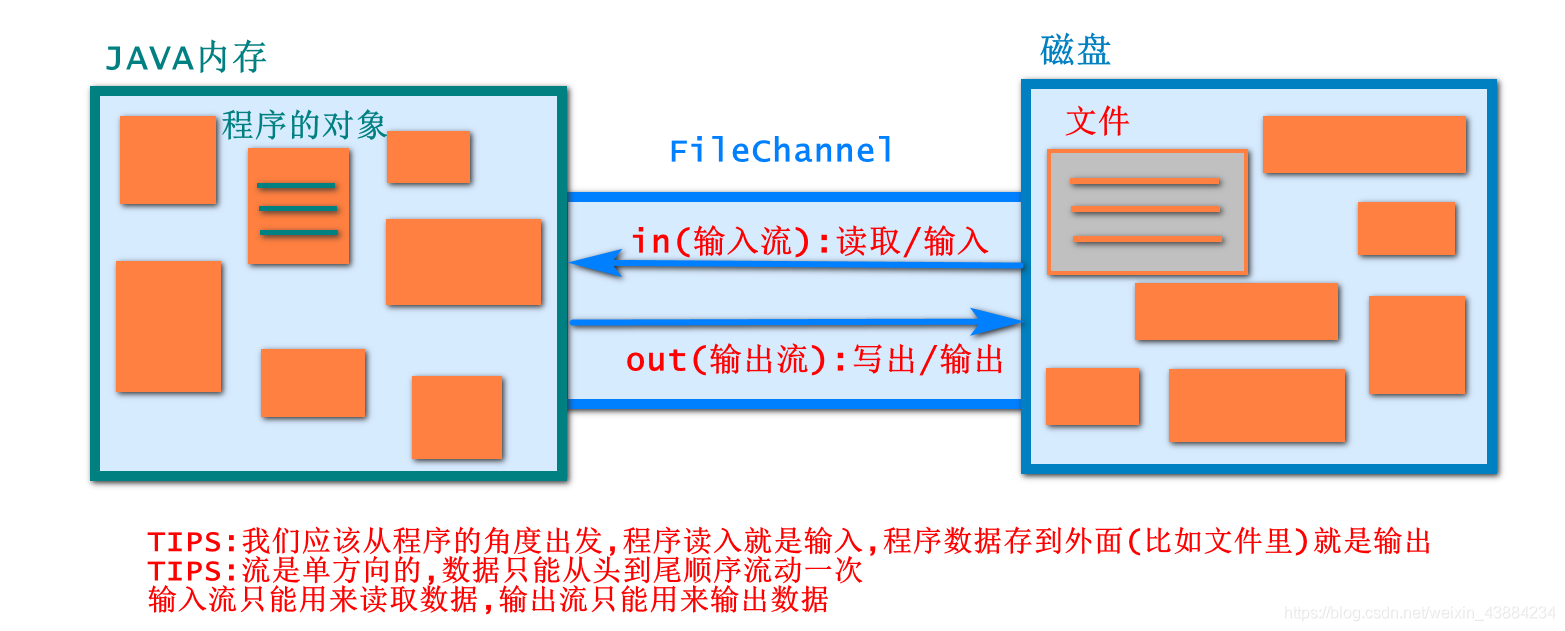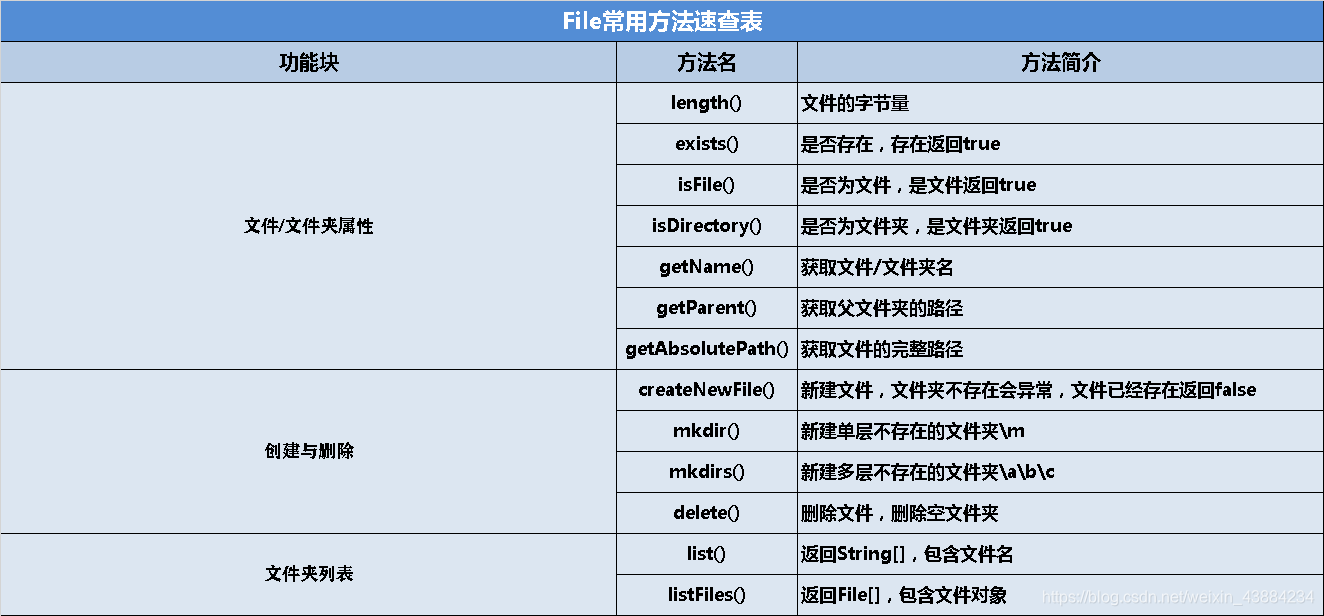前言 本篇参考文章为:
1.https://blog.csdn.net/weixin_43884234/article/details/116952152
一、IO简介 1.1 流Stream 在学习IO之前,我们需要先了解一下stream流的概念。为了便于理解,我们可以把数据的读写操作抽象成数据在“管道”中流动,这里需要注意一下几点:
流只能单方向移动
输入流用来读取
输出流用来写出
数据只能从头到尾地读写一次
所以以程序的角度来思考,In/out 相对于程序而言的输入(读取)/输出(写出)的过程.
二、IO流的继承结构 在java中,根据处理的数据单位不同,可以把流分为字节流 和字符流字符流 : 针对文本文件
File
字节流:针对二进制文件
InputStream
FileInputStream
BufferedInputStream
ObjectInputStream
OutputStream
FileOutputStream
BufferedOutputStream
ObjectOutputStream
字符流:针对文本文件
Reader
FileReader
BufferedReader
InputStreamReader
Writer
FileWriter
BufferedWriter
OutputStreamWriter
PrintWriter一行行写出
三、File文件类 3.1 概述 封装一个磁盘路径字符串,对这个路径可以执行一次操作
可以封装文件路径、文件夹路径、不存在的路径
3.2 创建对象 File(String pathname)通过将给定路径名字符串转换为抽象路径名来创建一个新的File实例
3.3 常用方法
3.4 练习:测试常用方法 1 2 3 4 5 6 7 8 9 10 11 12 13 14 15 16 17 18 19 20 21 22 23 24 25 26 27 28 29 30 31 32 33 34 35 36 37 38 39 40 41 42 43 44 45 46 47 48 49 50 51 52 53 54 55 56 57 58 public class FileTest01 public static void main (String[] args) throws IOException File file = new File("E:\\OneDrive\\桌面\\file\\1.txt" ); System.out.println(file.length()); System.out.println(file.exists()); System.out.println(file.isFile()); System.out.println(file.isDirectory()); System.out.println(file.getName()); System.out.println(file.getParent()); System.out.println(file.getAbsolutePath()); file = new File("E:\\OneDrive\\桌面\\file\\2.txt" ); System.out.println(file.createNewFile()); file = new File("E:\\OneDrive\\桌面\\file\\m" ); System.out.println(file.mkdir()); file = new File("E:\\OneDrive\\桌面\\file\\a\\b\\c" ); System.out.println(file.mkdirs()); System.out.println(file.delete()); file = new File("E:\\OneDrive\\桌面\\file\\a" ); System.out.println(file.delete()); file = new File("E:\\OneDrive\\桌面\\file\\2.txt" ); System.out.println(file.delete()); file = new File("E:\\OneDrive\\桌面" ); String[] list = file.list(); System.out.println(Arrays.toString(list)); File[] fs = file.listFiles(); System.out.println(Arrays.toString(fs)); System.out.println(fs[0 ].isDirectory()); } }
四、字节流读取 字节流是由字节组成的,字符流是由字符组成的.
此抽象类是表示字节输入流的所有类的超类/抽象类,不可创建对象
常用方法 :
常用方法:
直接插在文件上,直接读取文件数据
创建对象
BufferedInputStream 为另一个输入流添加一些功能,在创建BufferedInputStream 时,会创建一个内部缓冲区数组(默认8k大小)。在读取或跳过流中的字节时,可根据需要从包含的输入流再次填充该内部缓冲区,一次填充多个字节。
1 2 3 创建对象 BufferedInputStream (InputStream in) 创建一个 BufferedInputStream 并保存其参数,即输入流 in ,以便将来使用。
4.4 练习:字节流读取案例 1 2 3 4 5 6 7 8 9 10 11 12 13 14 15 16 17 18 19 20 21 22 23 24 25 26 27 28 29 30 31 32 33 34 35 36 37 38 39 40 41 42 43 44 45 46 47 48 49 50 51 52 53 54 55 56 57 58 59 60 61 62 63 64 65 66 67 68 69 70 71 public class BytesStream public static void main (String[] args) throws IOException method2(); } private static void method () InputStream in = null ; try { in = new FileInputStream(new File("E:\\OneDrive\\桌面\\file\\1.txt" )); int b; while ((b = in.read()) != -1 ){ System.out.println(b); } } catch (IOException e) { throw new RuntimeException(e); } finally { try { in.close(); } catch (IOException e) { throw new RuntimeException(e); } } } private static void method2 () throws IOException InputStream in = null ; try { in = new BufferedInputStream(new FileInputStream(new File("E:\\OneDrive\\桌面\\file\\1.txt" ))); int b; while ((b = in.read()) != -1 ){ System.out.println(b); } } catch (Exception e) { throw new RuntimeException(e); } finally { in.close(); } } }
五、字符流读取 常用于处理纯文本数据,读写容易出现乱码的现象,在读写时,最好指定编码集为UTF-8
5.1 Reader抽象类 用于读取字符流的抽象类。
常用方法:
1 2 3 4 5 int read () 读取单个字符int read (char [] cbuf) 将字符读入数组abstract int read (char [] cbuf, int off, int len) 将字符读入数组的某一部分int read (CharBuffer target) 试图将字符读入指定的字符缓冲区abstract void close() 关闭该流并释放与之关联的所有资源
5.2 FileReader子类 用来读取字符文件的便捷类。此类的构造方法假定默认字符编码和默认字节缓冲区大小都是适当的。要自己指定这些值,可以先在 FileInputStream 上构造一个 InputStreamReader。
1 2 3 创建对象 FileReader (String fileName) FileReader (File file)
5.3 BufferedReader子类 从字符输入流中读取文本,缓冲各个字符,从而实现字符、数组和行的高效读取。
1 2 创建对象 BufferedReader (Reader in)
5.4 练习:字符流读取案例 1 2 3 4 5 6 7 8 9 10 11 12 13 14 15 16 17 18 19 20 21 22 23 24 25 26 27 28 29 30 31 32 33 34 35 36 37 38 39 40 41 42 43 44 45 46 47 48 49 50 51 52 53 54 55 56 57 58 59 60 61 62 package cn.tedu.file;import java.io.*;public class TestIn2 public static void main (String[] args) method2(); } private static void method2 () Reader in=null ; try { in = new BufferedReader(new FileReader("E:\\ready\\1.txt" )); int b; while ((b=in.read())!=-1 ){ System.out.println(b); } }catch (Exception e){ e.printStackTrace(); }finally { try { in.close(); } catch (IOException e) { e.printStackTrace(); } } } private static void method () Reader in = null ; try { in = new FileReader("E:\\ready\\1.txt" ); int b; while ((b = in.read())!= -1 ){ System.out.println(b); } } catch (Exception e) { e.printStackTrace(); } finally { try { in.close(); } catch (IOException e) { e.printStackTrace(); } } } }
六、字节流写出 6.1 OutputStream抽象类 此抽象类是表示输出字节流的所有类的超类.输出流接受输出字节并将这些字节发送到某个接收器.
常用方法:
1 2 3 4 5 Void close() 关闭此输出流并释放与此流相关的所有系统资源Void flush() 刷新此输出流并强制写出所有缓冲的输出字节Void write (byte [ ] b) 将b.length个字节从指定的byte 数组写入此输出流Void write (byte [ ] b,int off ,int len) 将指定byte 数组中从偏移量off开始的len个字节写入输出流Abstract void write (int b) 将指定的字节写入此输出流
6.2 FileOutputStream 子类 直接插在文件上,直接写出文件数据
1 2 3 4 5 6 7 构造方法(创建对象): FileOutputStream(String name) 创建一个向具有指定名称的文件中写入数据的文件输出流 FileOutStream(File file ) 创建一个向指定File 对象表示的文件中写入数据的文件输出流 FileOutStream(File file ,boolean append )—如果第二个参数为true ,表示追加,不覆盖 创建一个向指定File 对象表示的文件中写入数据的文件输出流,后面的参数是指是否覆盖原文件内容
6.3 BufferedOutputstream 子类 该类实现缓冲的输出流,通过设置这种输出流,应用程序就可以将各个字节写入底层输出流中,而不必每次针对字节写出调用底层系统
1 2 3 构造方法(创建对象): BufferedOutputStream (OutputStream out) 创建一个新的缓冲输出流,用以将数据写入指定的底层输出流
6.4 练习: 字节输出流测试 1 2 3 4 5 6 7 8 9 10 11 12 13 14 15 16 17 18 19 20 21 22 23 24 25 26 27 28 29 30 31 32 33 34 35 36 37 38 39 40 41 42 43 44 45 46 47 48 49 50 51 52 53 54 55 56 57 58 59 package cn.tedu.file;import java.io.*;public class TestOut public static void main (String[] args) method(); } private static void method2 () OutputStream out = null ; try { out = new BufferedOutputStream(new FileOutputStream("E:\\ready\\2.txt" )); out.write(97 ); out.write(97 ); out.write(97 ); }catch (Exception e){ e.printStackTrace(); }finally { try { out.close(); } catch (IOException e) { e.printStackTrace(); } } } private static void method () OutputStream out = null ; try { out = new FileOutputStream("E:\\ready\\2.txt" ,true ); out.write(99 ); out.write(99 ); out.write(99 ); }catch (Exception e){ e.printStackTrace(); }finally { try { out.close(); } catch (IOException e) { e.printStackTrace(); } } } }
七、字符流写出 7.1 Writer 抽象类 写入字符流的抽象类
常用方法:
1 2 3 4 5 6 Abstract void close () 关闭此流,但要先刷新它 Void write (char [ ] cbuf) 写入字符数组Void write (int c) 写入单个字符Void write (String str) 写入字符串Void write (String str,int off ,int len) 写入字符串的某一部分Abstract void write (char [] cbuf,int off ,int len)写入字符数组的某一部分
7.2 FileWriter 子类 用来写入字符文件的便捷类,此类的构造方法假定默认字符编码和默认字节缓冲区大小都是可接受的.如果需要自己自定义这些值,可以先在FileOutputStream上构造一个OutputStreamWriter.
1 2 3 4 5 构造方法(创建对象): FileWriter(String filename ) 根据给定的文件名构造一个FileWriter对象 FileWriter(String filename ,boolean append ) 根据给定的文件名以及指示是否附加写入数据的boolean值来构造FileWriter
7.3 BufferedWriter子类 将文本写入字符输出流,缓冲各个字符,从而提供单个字符,数组和字符串的高效写入.可以指定缓冲区的大小,或者接受默认的大小,在大多数情况下,默认值就足够大了
1 2 3 构造方法(创建对象): BufferedWriter (Writer out) 创建一个使用默认大小输出缓冲区的缓冲字符输出流
7.4 练习: 字符输出流测试 1 2 3 4 5 6 7 8 9 10 11 12 13 14 15 16 17 18 19 20 21 22 23 24 25 26 27 28 29 30 31 32 33 34 35 36 37 38 39 40 41 42 43 44 45 46 47 48 49 50 51 52 53 54 55 56 57 58 59 60 61 62 package cn.tedu.file;import java.io.*;public class TestOut2 public static void main (String[] args) method2(); } private static void method2 () Writer out = null ; try { out = new BufferedWriter(new FileWriter("E:\\ready\\2.txt" ,true )); out.write(100 ); out.write(100 ); out.write(100 ); out.write(100 ); out.write(100 ); }catch (Exception e){ e.printStackTrace(); }finally { try { out.close(); } catch (IOException e) { e.printStackTrace(); } } } private static void method () Writer out = null ; try { out = new FileWriter("E:\\ready\\2.txt" ,true ); out.write(98 ); out.write(98 ); out.write(98 ); out.write(98 ); }catch (Exception e){ e.printStackTrace(); }finally { try { out.close(); } catch (IOException e) { e.printStackTrace(); } } } }
八、扩展 通过学习以上的几种流,我们也可以拓展尝试做下文件的复制操作:
1 2 3 4 5 6 7 8 9 10 11 12 13 14 15 16 17 18 19 20 21 22 23 24 25 26 27 28 29 30 31 32 33 34 35 36 37 38 39 40 41 42 43 44 45 46 47 48 49 50 51 52 53 54 55 56 57 58 59 60 61 62 63 64 65 66 67 68 69 70 71 72 73 74 75 76 77 78 79 80 81 82 83 84 85 86 87 88 89 90 91 92 93 94 95 96 package cn.tedu.file;import java.io.*;import java.util.Scanner;public class TestCopyFile public static void main (String[] args) System.out.println("请输入源文件路径" ); String f = new Scanner(System.in).nextLine(); System.out.println("请输入新文件路径:" ); String t = new Scanner(System.in).nextLine(); ZJCopy(f,t); } private static void ZJCopy (String f, String t) InputStream in = null ; OutputStream out = null ; try { in = new BufferedInputStream(new FileInputStream(f)); out = new BufferedOutputStream(new FileOutputStream(t)); int b; while ((b = in.read()) != -1 ){ out.write(b); } System.out.println("恭喜您!文件复制成功!" ); }catch (Exception e){ System.out.println("很抱歉!文件复制失败!" ); e.printStackTrace(); }finally { try { out.close(); } catch (IOException e) { e.printStackTrace(); } try { in.close(); } catch (IOException e) { e.printStackTrace(); } } } private static void ZFCopy (String f, String t) Reader in = null ; Writer out = null ; try { in = new BufferedReader(new FileReader(f)); out = new BufferedWriter(new FileWriter(t)); int b; while ((b=in.read())!=-1 ) { out.write(b); } System.out.println("恭喜您!文件复制成功!" ); }catch (Exception e){ System.out.println("很抱歉!文件复制失败!" ); e.printStackTrace(); }finally { try { out.close(); } catch (IOException e) { e.printStackTrace(); } try { in.close(); } catch (IOException e) { e.printStackTrace(); } } } }
九、总结:IO的继承结构 1.主流分类 按照方向进行分类:输入流 输出流(相对于程序而言,从程序写数据到文件中是输出)
2.学习方法:在抽象父类中学习通用的方法,在子类中学习如何创建对象 3.字节输入流: InputStream 抽象类,不能new,可以作为超类,学习其所提供的共性方法
4.字符输入流 Reader 抽象类,不能new,可以作为超类,学习其所提供的共性方法
5.字节输出流: OutputStream 抽象类,不能new,可以作为超类,学习其所提供的共性方法
6.字符输出流 Writer 抽象类,不能new,可以作为超类,学习其所提供的共性方法


